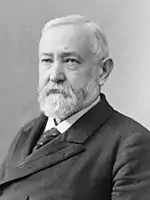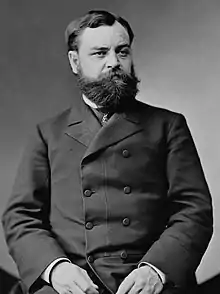1892 Republican National Convention
The 1892 Republican National Convention was held at the Industrial Exposition Building, Minneapolis, Minnesota, from June 7 to June 10, 1892. The party nominated President Benjamin Harrison for re-election on the first ballot and Whitelaw Reid of New York for vice president.[1]
| 1892 presidential election | |
  Nominees Harrison and Reid | |
| Convention | |
|---|---|
| Date(s) | June 7–10, 1892 |
| City | Minneapolis, Minnesota |
| Venue | Industrial Exposition Building |
| Chair | William McKinley |
| Candidates | |
| Presidential nominee | Benjamin Harrison of Indiana |
| Vice presidential nominee | Whitelaw Reid of New York |
| Other candidates | James G. Blaine William McKinley |
| Voting | |
| Total delegates | 906 |
| Votes needed for nomination | 454 |
| Results (president) | Harrison (IN): 535.17 (59.07%) McKinley (OH): 182 (20.09%) Blaine (ME): 181.83 (20.07%) Reed (ME): 4 (0.44%) Lincoln (IL): 1 (0.11%) |
| Ballots | 1 |
James S. Clarkson of Iowa was the outgoing chairman of the Republican National Committee. J. Sloat Fassett of New York was Temporary Chairman, and Governor William McKinley Jr. of Ohio was the Permanent Chair of the convention.
Harrison's Secretary of State James G. Blaine, who had resigned from the cabinet on June 4, 1892, the eve of the convention, had his name submitted for consideration by the delegates, but drew little support. Future president William McKinley barely edged out Blaine for second place among the delegates.
Although successful in his bid for re-nomination, President Harrison's performance was underwhelming for an incumbent, due in part to the crushing defeat that the party had suffered in the 1890 mid-term elections. He and Reid would lose the fall 1892 election to former President Grover Cleveland and Adlai Stevenson.
The 1892 RNC was also the first convention where women were allowed to be delegates. Therese Alberta (Parkinson) Jenkins, delegate from Wyoming, cast the first vote by a woman for president; Wyoming had granted full suffrage for women at statehood in 1890.
Presidential nomination
Presidential candidates
President Harrison had proven unpopular with the party and the country. There were divisions even within the Republican party as the year 1892 began and Harrison began his re-election drive. Although no declared Republican candidate opposed Harrison, many Republicans were ready to dump the president from the ticket if an alternative emerged. Among the possible candidates spoken of were McKinley, Reed, and the aging Blaine.
Fearing that the Ohio governor would emerge as a candidate, Harrison's managers arranged for McKinley to be permanent chairman of the convention in Minneapolis, requiring him to play a public, neutral role. Hanna established an unofficial McKinley headquarters near the convention hall, though no active effort was made to convert delegates to McKinley's cause.
Many of Blaine's old supporters encouraged him to run for the nomination.[2] Blaine had denied any interest in the nomination months before his resignation, but some of his friends, including Senator Matthew Quay of Pennsylvania and James S. Clarkson, chairman of the Republican National Committee, took it for false modesty and worked for his nomination anyway.[3] When Blaine resigned from the cabinet, his boosters were certain that he was a candidate.[4] However, Blaine, sent word he did not want to be considered.
After the balloting commenced, McKinley objected to delegate votes being cast for him.[5] Despite the efforts to draft McKinley and Blaine, the majority of the party stood by the incumbent. Harrison was re-nominated on the first ballot.
| Presidential Ballot | |
|---|---|
| Candidate | 1st |
| Harrison | 535.17 |
| McKinley | 182 |
| Blaine | 181.83 |
| Reed | 4 |
| Lincoln | 1 |
| Not Voting | 2 |
Presidential Balloting / 4th Day of Convention (June 10, 1892)
 1st Presidential Ballot
1st Presidential Ballot
Source: US President - R Convention. Our Campaigns. (January 8, 2010). Source: US Vice President - R Convention. Our Campaigns. (September 7, 2009).
Vice Presidential nomination
Vice Presidential candidates
Vice President Levi Morton was dumped from the ticket, as Harrison was not particularly fond of Morton, who was closer to Blaine supporters; Morton himself was not interested in serving another term as Vice President in any event, having been persuaded by his confidantes to run for governor of New York at the next scheduled election in 1894.[6] Morton was replaced by Ambassador Whitelaw Reid of New York by unanimous acclamation.
This was also the first, and so far only, time in U.S. political history where the presidential and vice presidential nominees were both graduates from the same university: Harrison and Reid were graduates of Miami University located in Oxford, Ohio.
Republican Party Platform
The Republican platform supported high tariffs, bimetallism, stiffer immigration laws, free rural mail delivery, and a canal across Central America. It also expressed sympathy for the Irish Home Rule Movement and the plight of Jews under persecution in czarist Russia.[7]
See also
References
- "Different twin city, but a similar RNC tale 116 years later". Twin Cities. 2008-08-10. Retrieved 2018-05-29.
- Calhoun, pp. 134–139; Muzzey, pp. 468–469.
- Muzzey, pp. 469–472.
- Muzzey, pp. 473–479.
- Horner, pp. 92–96.
- "Levi Parsons Morton, 22nd Vice President (1889-1893)". US Senate. US Senate. Retrieved 9 October 2015.
- History of American Presidential Elections Volume II 1848-1896; Schlesinger; Pgs 1739-1741
Bibliography
- Calhoun, Charles William (2005). Benjamin Harrison. New York: Times Books. ISBN 978-0-8050-6952-5.
- Horner, William T. (2010). Ohio's Kingmaker: Mark Hanna, Man and Myth. Athens, Ohio: Ohio University Press. ISBN 978-0-8214-1894-9.
- Huber, Molly (April 26, 2011). "Republican National Convention, June 1892". MNopedia. Minnesota Historical Society. Retrieved November 3, 2012.
- Muzzey, David Saville (1934). James G. Blaine: A Political Idol of Other Days. New York: Dodd, Mead, and Company.
External links
- Republican Party platform of 1892 at The American Presidency Project
- Harrison acceptance letter at The American Presidency Project
| Preceded by 1888 Chicago, Illinois |
Republican National Conventions | Succeeded by 1896 St. Louis, Missouri |

.jpg.webp)

.jpg.webp)


.jpg.webp)

